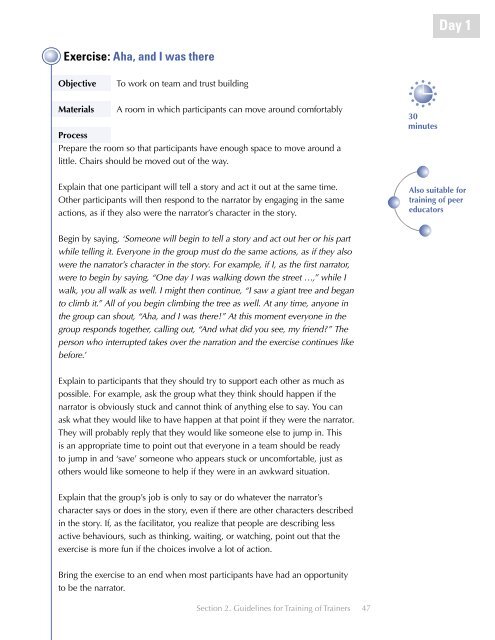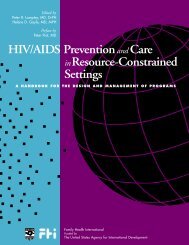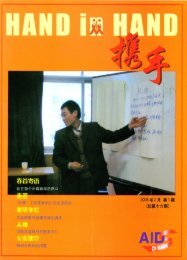The Training of Trainers Manual - UNFPA
The Training of Trainers Manual - UNFPA
The Training of Trainers Manual - UNFPA
You also want an ePaper? Increase the reach of your titles
YUMPU automatically turns print PDFs into web optimized ePapers that Google loves.
Day 1<br />
Exercise: Aha, and I was there<br />
Objective<br />
To work on team and trust building<br />
Materials A room in which participants can move around comfortably<br />
Process<br />
Prepare the room so that participants have enough space to move around a<br />
little. Chairs should be moved out <strong>of</strong> the way.<br />
30<br />
minutes<br />
Explain that one participant will tell a story and act it out at the same time.<br />
Other participants will then respond to the narrator by engaging in the same<br />
actions, as if they also were the narrator’s character in the story.<br />
Also suitable for<br />
training <strong>of</strong> peer<br />
educators<br />
Begin by saying, ‘Someone will begin to tell a story and act out her or his part<br />
while telling it. Everyone in the group must do the same actions, as if they also<br />
were the narrator’s character in the story. For example, if I, as the first narrator,<br />
were to begin by saying, “One day I was walking down the street …,” while I<br />
walk, you all walk as well. I might then continue, “I saw a giant tree and began<br />
to climb it.” All <strong>of</strong> you begin climbing the tree as well. At any time, anyone in<br />
the group can shout, “Aha, and I was there!” At this moment everyone in the<br />
group responds together, calling out, “And what did you see, my friend” <strong>The</strong><br />
person who interrupted takes over the narration and the exercise continues like<br />
before.’<br />
Explain to participants that they should try to support each other as much as<br />
possible. For example, ask the group what they think should happen if the<br />
narrator is obviously stuck and cannot think <strong>of</strong> anything else to say. You can<br />
ask what they would like to have happen at that point if they were the narrator.<br />
<strong>The</strong>y will probably reply that they would like someone else to jump in. This<br />
is an appropriate time to point out that everyone in a team should be ready<br />
to jump in and ‘save’ someone who appears stuck or uncomfortable, just as<br />
others would like someone to help if they were in an awkward situation.<br />
Explain that the group’s job is only to say or do whatever the narrator’s<br />
character says or does in the story, even if there are other characters described<br />
in the story. If, as the facilitator, you realize that people are describing less<br />
active behaviours, such as thinking, waiting, or watching, point out that the<br />
exercise is more fun if the choices involve a lot <strong>of</strong> action.<br />
Bring the exercise to an end when most participants have had an opportunity<br />
to be the narrator.<br />
Section 2. Guidelines for <strong>Training</strong> <strong>of</strong> <strong>Trainers</strong><br />
47

















